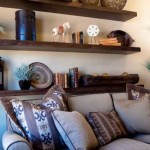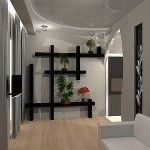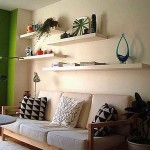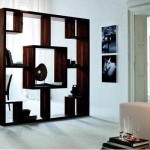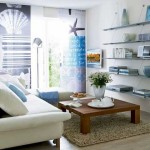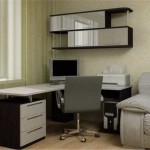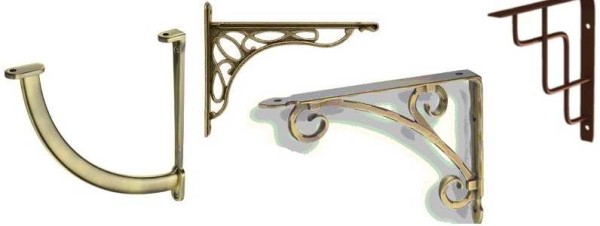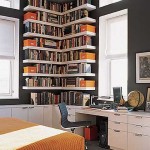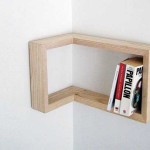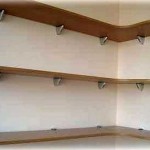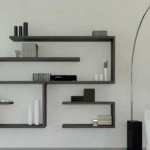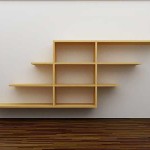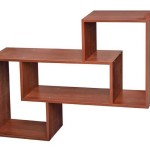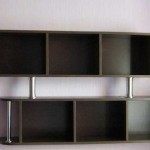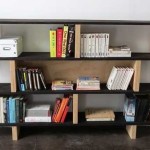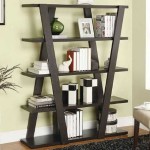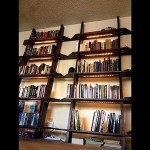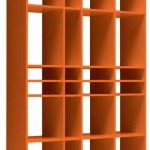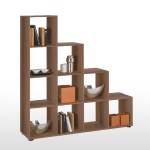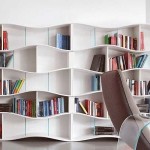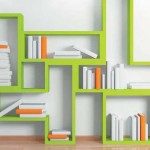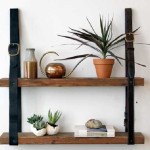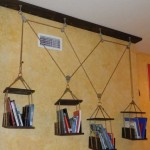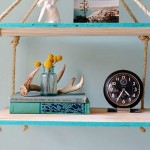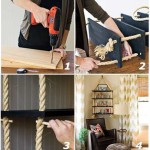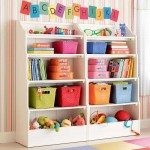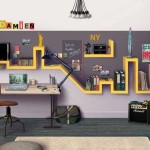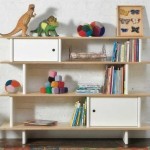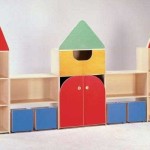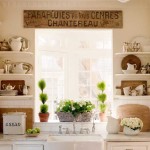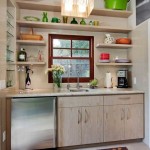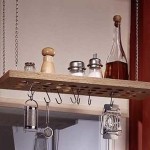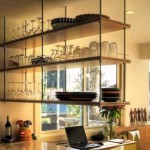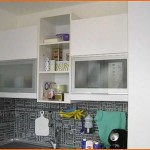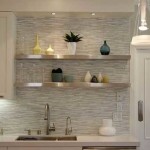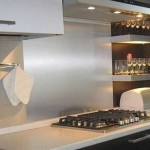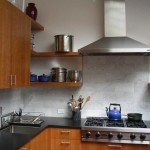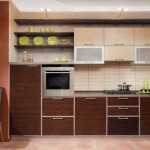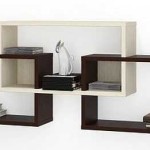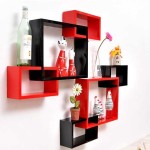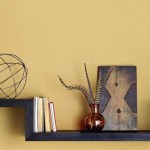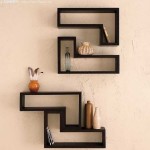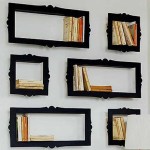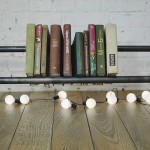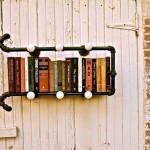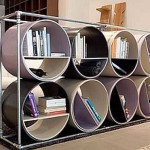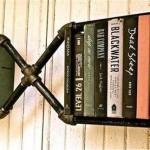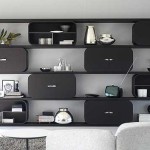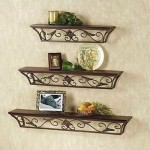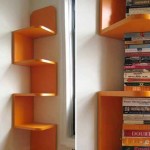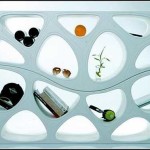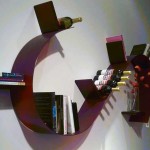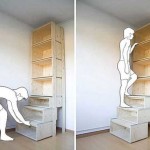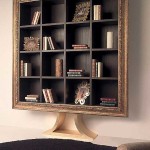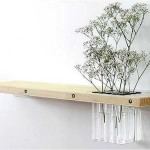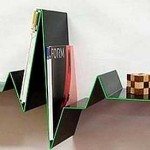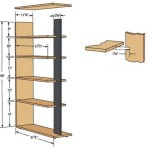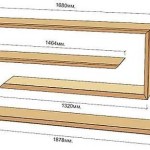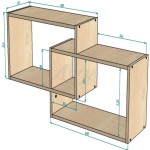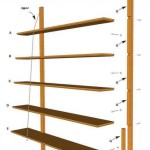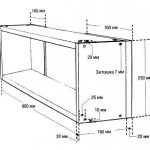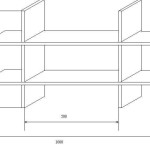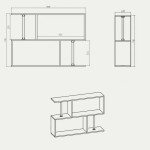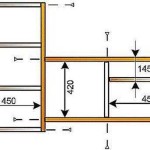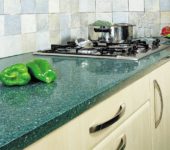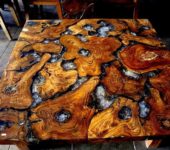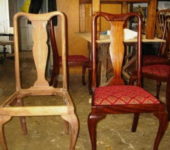Wall shelves: 60 photos and 8 drawings
One of the techniques for decorating a room is using shelves. But they are not only a decoration. Much more often they are functional. Shelves are hung on the wall, placed on the floor, some are hung from the ceiling or beams. But best of all - they are easy to make yourself, with your own hands.
The content of the article
Types of shelves in the house
At the place of installation, shelves are wall-mounted, floor-mounted and suspended. If the floor shelf has a large height - from a meter or more, it is often called a rack. A few words about suspended ones: usually these are decorative structures that hang on a pipe or a specially hammered bracket. This option is popular in those rooms where the heating pipes run under the ceiling: they just ask to be hung on them. Shelves in the kitchen and in the bathroom are hung on the pipe: it is convenient there.

These hanging kitchen shelves are comfortable and functional. On the same pipe, you can have a story and do it yourself
They are made of wood, plywood, laminated chipboard, Fiberboard, glass shelves. The same materials are used as racks, but they are also made of metal, plastics and other completely incredible things - for example, pipes or bottles.
In living rooms, it is not so important what material the shelf is made of. It is important that its design is in the same style as the interior. Even functionality is not always important: some play an exclusively decorative role. If there is one or two items on them. Their role is to give the interior of the home a special style and color.
- The intimate atmosphere of this room is enhanced by cozy pillows and dark wood shelves.
- The laconic style of apartment decoration and the same laconic shelves in a contrasting color. In this interior, they are the main element.
- The free space above the sofa is organically filled with shelves to match the walls
- The shelf can serve as a divider for areas in the room
- Light interior in light colors and the same shelves
- The shape and color of the shelves matches the shape and color of the table drawers
If we talk about shelves in technical rooms - the kitchen and the bathroom, in particular, the requirements for practicality are almost everywhere added to considerations of aesthetics. Even decorative kitchen shelves should be cleaned well. For shelves in the bathroom, the requirements are generally high: periodically there is very high humidity and materials are required that transfer it without any harm. There are not many of them. It is plastic and stainless steel. They also make bathroom shelves from MDF, but they are normally operated with good ventilation in the bathroom.
Wall shelves
In any room, there are places on the wall that you just need to hang something on. After all, most modern furniture occupies only the lower part - sofas, tables, couches. The upper part remains empty and dissonance arises: the overloaded lower part of the room and the half-empty or completely empty upper part. These voids on the walls are organically filled with shelves.
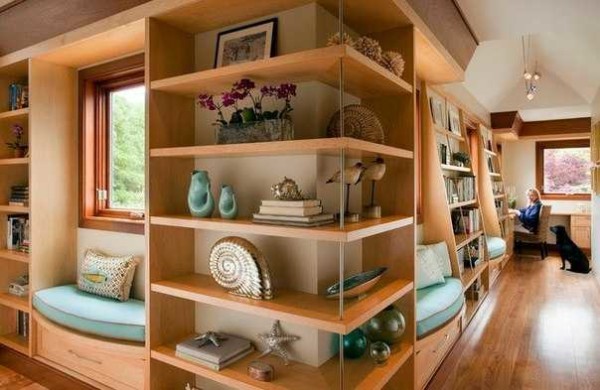
The whole system, and the most "dead" space is used - the angle
Structurally, most shelves consist of shelves proper and lintels. But these components are combined into so many options that it is impossible to count. A simple design is good: you can make any shelves yourself. Moreover, these products may be the first self-made things. It's really simple.
How and what to attach
It is not in vain that we start with fasteners. The design of the wall shelf largely depends on the type of attachment.Or maybe the opposite. It depends on what to dance from ...
Traditional hinges
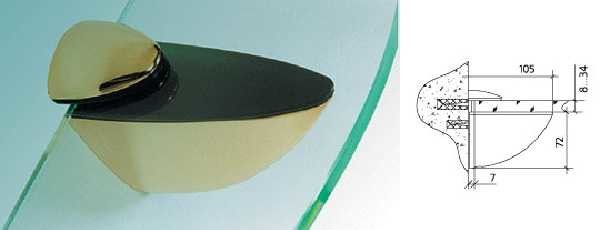
Wall mount glass shelf
There are other forms of similar fasteners. There are several of them in the photo below.
Decorative brackets
Another type of attachment is brackets. They are reliable, some are decorative, and so much so that they themselves are decoration.
Flush mounting - unsupported shelves
And the most amazing device for flush mounting. It makes it possible to hide the fasteners. At the end, a seat is cut out for the pin and the holder body and the shelf is simply put on it.

Countersunk shelf fasteners
As you can see, even a simple board or a piece of glass on such mounts is already good. But there is still a sea of all kinds of ideas.
About, how to update old furniture, read here.
Bookshelves
Strength requirements are imposed on bookshelves: they hold significant weight. Therefore, the fastening and materials and construction must be reliable. Traditionally, book shelves are made of wood, laminated or veneered fiberboard. And then fiberboard with a long span (more than 90 cm) bends over the years.
When planning shelves on the walls for books of your own size, keep in mind that the distance between the supports should not be more than 90 cm. Then, even when fully loaded, it will not bend. And there are two types and varieties of shelves: wall and floor. Both those and others can be angular.
In the simplest case, this is a board fixed in one of the ways. Some options, especially when served correctly, look very good.
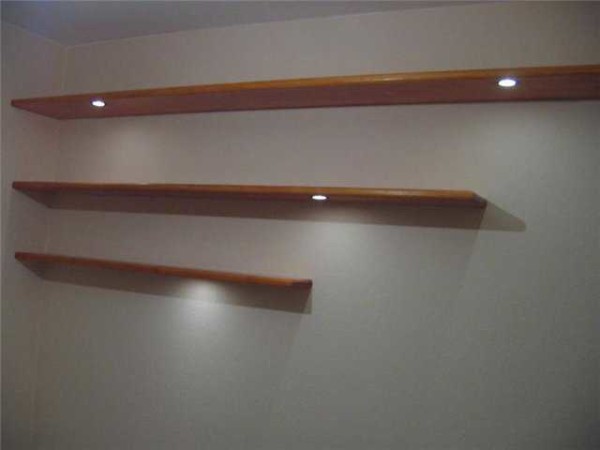
The simplest design shelf for the bottom of the wall for books (using a secret mount)
And if you have imagination, several boards turn into a very interesting thing, which can even be the main element of the decor. DIY ideas are collected in the photo gallery.
- And this is a serious way to expand the space due to the corners between two windows.
- A very interesting idea of using corners for small shelves
- Corner wall shelf for books. Mounted on pelicans))
- Contrasting color makes this shelf in the spotlight
- Nothing complicated: it's easy to assemble such a bookshelf with your own hands, and the view is non-standard
- Non-linearity - they are always interesting, and on such a shelf you can put books of different heights
- Small pipe bridging system
Floor-standing bookshelves can be loaded more seriously. Here the forms are different: there are racks to which the shelves are attached. A zest can be a broken or unusual line of shelves, as well as interesting racks.
- Simple design benefits from color and bridging
- Unusual racks adorn this floor-standing bookshelf
- This is more like a bookcase or even a wardrobe, but the essence does not change - the original color and interesting small shelves in the central part and the structure looks interesting
- Easy to manufacture and original
- A very interesting idea - non-linear shelves and lintels made of thick glass
- It's more like a shelf system
Read about the manufacture of fountains (both small indoor fountains, and more solid ones for a summer cottage, backyard or garden plot). here.
Suspended
Not very numerous, but original type. The most important thing is that it can be done easily: a few planks, four ropes or two belts and you can get to work.
- Old leather straps can also be the main harness
- It's a complex block system ... and the shelves can be at any level
- Two planks, four ropes and half an hour of time - all that is needed to make this shelf
- How to make a hanging shelf - graphic step by step instructions
To the nursery
While the child is very small, I want functional shelves, but with children's drawings. But where to get such? Do it yourself.Any shelf of the configuration you like can be pasted over with wallpaper on a non-woven base or thick wrapping paper (glued on PVA). After drying, coat twice with water-based varnish. Such shelves can be washed, but what is most interesting is that the shelf can change with the child. Tear off the old decor, glue the new one. The idea is simple, it works perfectly.

Here's what can happen
For children, the shelves are not very different in design. If we talk about floor or racks, then they must be strong: taking into account the fact that grown-up children will definitely want to climb on them. Therefore, often even those shelves that stand on the floor are attached additionally to the wall so that they do not collapse and crush young climbers. Based on these considerations, they are not made high: even if they fall, it's not scary.
The shelves in the children's room also differ in color - they are brighter, they can be made in the form of letters, boxes for toys can be installed in them: it is easier to keep them in order. In general, functionality and security should be combined.
- Drawer system - fast cleaning
- Children grow, design and colors change
- A combination of open and closed shelves - convenient for preschool children
- The fairytale town will appeal to both boys and girls
Read about the development of the design of a children's room here.
Shelves and shelves in the kitchen
Whatever you say, but the main thing in the kitchen is functionality. There is not much free space even on the walls: lockers take up a large area. Therefore, one of the tasks is to make the most of the free space. There are interesting ideas for small or even very small gaps between the wall and the refrigerator or other household appliances. Strictly in size, you can make a pouch on wheels, which goes out and completely hides there. It is wide and narrow (see photo).
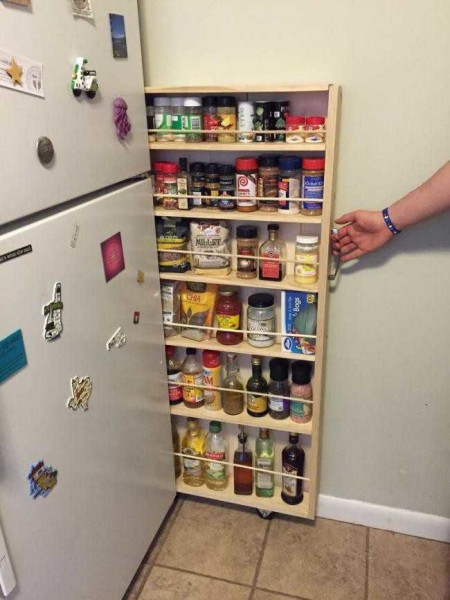
It is not difficult to make such a sliding shelf-rack on wheels for different jars. Everything you need is at hand and does not interfere
There are also interesting ideas for saving space. If a sink or a hundred stands near the window, you can take the sidewalls. There is an interesting hanging option - a lattice on chains, to which all utensils cling. But such a shelf is possible if the desk is not against the wall. Another option to save space - if the kitchen-dining room is zoned with a counter, you can also make a shelf above it, which will be partially suspended. One part of it rests on the wall, the other - on the counter or "hangs" on the ceiling.
- We take up all the free space
- Shelves near the window in a different style
- Hanging shelf for small items
- There is also unused space above the counter
Read about how to arrange kitchen furniture here.
Hanging the entire wall above the desk with lockers is not the best solution. They look heavy. You can solve the problem with glass doors, but not everyone likes it. The way out is to make open shelves between the cabinets. They will give more lightness to the interior and the work area will not put so much pressure on the rest of the space.
- Slashed and open shelves will "lighten" the interior
- Stylish accessories will not hurt
- There is also a place for glasses
- The style is different - the idea is the same
- Closed and open shelves in one system - convenient and non-standard
Decorative and original
Often, wall shelves play an exclusively decorative role. They are designed to attract attention and this goal is achieved by an unusual form, contrasting with the walls, color. You can't put much on it: one or two things, but how interesting they are.
- Only three rectangles, but due to the color and binding they look very stylish
- Another option from different rectangles and squares, and even painted in bright contrasting colors. You will not pass by
- A very interesting idea of using corners for small shelves
- The theme is the same, the mood is different.And only due to the fact that the contrast between the color of the wall and the color of the shelf is not so bright
- Another option for "square" shelves. Two identical kits arranged differently
- If traditional square shelves are decorated around the edge with curly frames, the style is completely different.
Another interesting topic is glass shelves. Just one glass is not very interesting. Its combination with wood and steel is more attractive. The effects are sometimes unexpected. The glass is collected on rails: the material is fragile and heavy and must be held. Steel can do it.
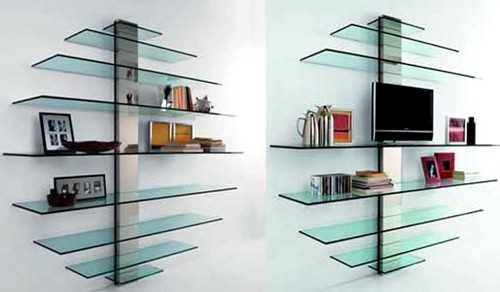
An interesting glass option. You can arbitrarily change the height between tiers
Actually, these systems are intended for creating interiors of shops, but also in a modern style apartment or loft style look stylish.
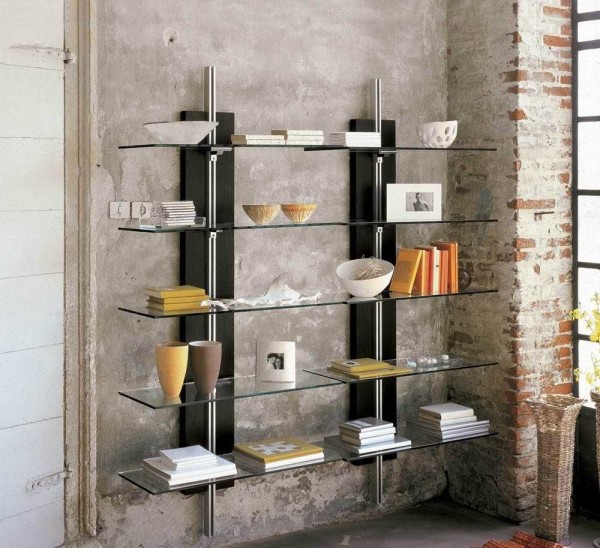
The "vintage" style is also suitable
What shelves are not made of. Even from pipes. Metal and plastic. Remaining images from repairs? Use it in business, and get a designer thing that is interesting, collected from trash.
- This is a floor version
- No need to paint plastic pipes
- Water pipes, corners, everything is painted with bronze paint
- Large diameter plastic pipes installed in the frame. Here's an unusual shelf
- Such is an interesting variation of a bookshelf made of pipes.
There are samples that are simply amazed. How could you come up with such a thing?
- A combination of open and closed shelves. Custom shape - rounded corners and a completely new look
- The forged base looks noble
- Custom corner shelf
- Can be an interesting partition between zones
- Something similar can be made from polycarbonate. They are of different colors and bend well
- A stormy flight of fantasy from the author
- Idea for those with many books
- Interesting design
- For cut flower lovers
- Shelf cardiogram ...
Shelf drawings
Basically, the constructions are simple: you looked and roughly imagine how to do it. For those who want to make shelves with their own hands, we give several drawings. Having them on hand, you can easily make the required changes in size. Just remember that from 16-18 mm thick fiberboard, the span between the supports should be no more than a meter, but better - 90 cm. Otherwise, there will be a deflection. The situation is about the same with plywood.
The only thing that might be unclear is how to collect some of the nodes. Let's explain in one diagram, the rest of the assembly is similar. All connections are made at the corners. To make the design reliable, the shelves are cut out intact, and jumpers are attached to them, at the corners.
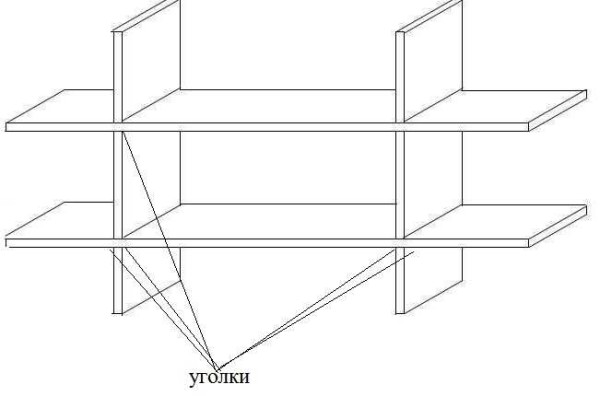
All these connections are made at the corners
The corners are installed from below, two for each connection on the right and left. They are made of metal or plastic. If the load is planned to be significant, put metal, if the shelves are decorative, you can use furniture made of plastic.

Some types of corners
Now you can make your favorite shelves on the wall with your own hands (and floor ones too).

